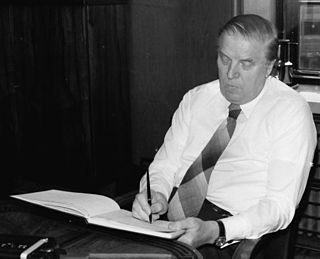
Urho Kaleva Kekkonen was a Finnish politician who served as the eighth and longest-serving President of Finland (1956–82). He ruled over Finland for nearly 26 years, and held a questionably large amount of power; he is often classified as an autocrat. Regardless, he remains a popular, respected and recognizable figure. Previously, he had served as Prime Minister of Finland, Minister of Foreign Affairs, Speaker of the Finnish Parliament (1948–50) and Minister of Justice. As president, Kekkonen continued the "active neutrality" policy of his predecessor President Juho Kusti Paasikivi, a doctrine that came to be known as the "Paasikivi–Kekkonen line", under which Finland retained its independence while maintaining good relations and extensive trade with members of both NATO and the Warsaw Pact. He hosted the European Conference on Security and Co-operation in Helsinki in 1975 and was considered a potential candidate for the Nobel Peace Prize that year.

The Centre Party of Finland is a centrist, liberal, agrarian political party in Finland.

Johannes Virolainen was a Finnish politician and who served as 30th Prime Minister of Finland.
Parliamentary elections were held in Finland on 6 and 7 July 1958. The communist Finnish People's Democratic League emerged as the largest party, but was unable to form a government.
Parliamentary elections were held in the Grand Duchy of Finland on 1 and 2 July 1908.
Parliamentary elections were held in the Grand Duchy of Finland on 1 and 3 July 1916.
Parliamentary elections were held in the Grand Duchy of Finland on 1 and 2 October 1917. The general voter turnout was higher than in previous elections. The Social Democrats lost the absolute majority that they had had in the previous two elections. In other words, the "bourgeois" (non-socialist) parties taken together now had more than half the seats.
Parliamentary elections were held in Finland on 1 and 2 July 1948.
Parliamentary elections were held in Finland on 1 and 2 July 1951.
Parliamentary elections were held in Finland on 7 and 8 March 1954.
Parliamentary elections were held in Finland on 4 and 5 February 1962.
Parliamentary elections were held in Finland on 20 and 21 March 1966. The Social Democratic Party (SDP) overtook the Centre Party as the largest faction in Parliament. Rafael Paasio of the SDP subsequently became Prime Minister and formed a popular front government consisting of the SDP, the Centre Party, the People's Democratic League (SKDL), and the Social Democratic Union of Workers and Smallholders (TPSL) in May 1966.
Parliamentary elections were held in Finland on 15 and 16 March 1970.
Parliamentary elections were held in Finland on 21 and 22 September 1975.
Parliamentary elections were held in Finland on 18 and 19 March 1979.

The Finnish Rural Party was an agrarian and populist political party in Finland. Starting as a breakaway faction of the Agrarian League in 1959, the party was identified with the person of Veikko Vennamo, a former Agrarian League Member of Parliament known for his opposition to the politics of President Urho Kekkonen. Vennamo was chairman of the Finnish Rural Party between 1959 and 1979.

Two-stage presidential elections were held in Finland in 1968. On 15 and 16 January the public elected presidential electors to an electoral college. They in turn elected the President. The result was a victory for Urho Kekkonen, who won on the first ballot. The turnout for the popular vote was 70.2.

Two-stage presidential elections were held in Finland in 1978, the first since 1968 after Urho Kekkonen's term was extended by four years by Parliament. The public elected presidential electors to an electoral college on 15 and 16 January. They in turn elected the President. The result was a victory for Urho Kekkonen, who won on the first ballot. The turnout for the popular vote was 64.3. Kekkonen had in the spring of 1975 agreed to become the Social Democratic presidential candidate, and after that all the major Finnish political parties chose him as their candidate. Kekkonen's opponents, such as the Christian League's presidential candidate Raino Westerholm, claimed that Kekkonen's long presidency weakened the Finnish democracy. Over one-third of the Finnish voters abstained from voting, partly as a protest against Kekkonen's expected landslide victory.














